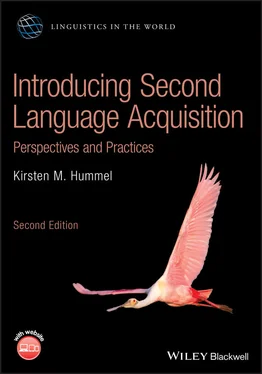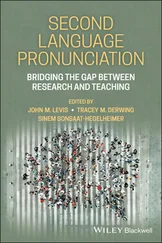Of course it is not necessary to believe the biblical story of Babel to understand the importance of being able to communicate with one's neighbor or with an individual on the other side of the globe. The desire to learn another language might stem from a personal choice to broaden one's horizons or from a more complex set of life circumstances, such as an urgent need to find a job in a new country. In addition, the growing ubiquity of international travel, along with electronic means of communicating across time zones, has increased opportunities to interact with speakers of other languages and, for many, may trigger the desire to undertake the learning of another language.

Cartoon 1.12/15/2000, http://www.reverendfun.com/needyreverendfun.com.
© 2015 HarperCollins Christian Publishing.
Second language acquisition is a phenomenon that millions of individuals worldwide are engaged in, and it is also a distinct field of study. The principal aim of this book is to provide an overview of the main concepts, issues, and debates in the field of SLA, referring to past and current research to illustrate these issues. There has been a huge increase in empirical research in the past few decades on a wide variety of topics related to SLA. Discussions throughout the book will refer to this research by highlighting specific studies to clarify important concepts and themes.
Research into SLA is a truly multidisciplinary endeavor. Some of the major disciplines that contribute to SLA include theoretical linguistics, education, psychology, and sociology. In the past several decades, the field of SLA has increasingly come to be recognized as a discipline of its own, supported by an abundant research literature. Universities now regularly offer courses in “second language acquisition” whereas in earlier years the subject was only briefly reviewed in the context of a basic introductory linguistics or second language pedagogy course, if at all. Today, disciplines as varied as theoretical linguistics, speech pathology, and educational psychology refer to aspects of the SLA research literature in their own fields, and in some instances data from SLA are used in testing theoretical models or describing concepts in other disciplines.
Note that an additional distinction between “second” language acquisition and “foreign” language acquisition is an important one in some contexts. In such cases, “second language acquisition” applies to circumstances in which the language learned (the target language) is generally the dominant language used in the learner's environment (such as an immigrants learning English in the United States), while “foreign language acquisition” indicates that the learner lives in the L1 environment and contact with target language speakers is not widely available (such as learning English in Beijing, China). In the context of learning English, a frequent abbreviation is “ESL” to refer to “English as a second language” and “EFL” for “English as a foreign language.” The use of the term “second language acquisition (SLA)” throughout this book generally includes foreign language acquisition, although the latter term will be used when it is important to make a distinction between the two circumstances.
The study of SLA also generally encompasses the acquisition of a third or additional languages (sometimes referred to as the study of multilingualism), although research specifically devoted to describing how third (or more) language acquisition might resemble or differ from SLA is increasing.
In addition, this book uses the terms “acquisition” and “learning” interchangeably as this usage has been generally adopted by scholars in the field (see, for example, Ortega 2009, p. 5).
Why study second language acquisition? To start, here are a number of questions that one might want some answers to:
Is second language acquisition like first language acquisition?
Does the first language help or get in the way of second language learning?
What are some of the circumstances in which people learn a second language?
Do innate capacities play an important role in second language acquisition?
Why do we make mistakes in a second language?
Do learners need their errors to be explicitly corrected?
Are there any universal processes affecting second language acquisition?
Is there a teaching method that has proved to be more successful than others?
Can adults learn to speak a second language as well as native speakers?
What about individual differences? Are there factors that enable some people to learn aspects of a second language better or faster than others?
Are there certain learning strategies that seem particularly useful?
What happens when children learn two languages at the same time? Do they end up confused and does one or both of their languages suffer?
Can bilinguals “turn off” or ignore one of their languages?
Our exploration throughout the field of second language acquisition will offer some responses to the preceding questions. We begin in Chapter 2by examining L1 acquisition. A basic understanding of this universal process, noting ways in which it resembles or differs from SLA, should be useful for gaining a clearer view of SLA. In the following chapter, Chapter 3, the reader is introduced to a selection of contexts, both naturalistic and classroom‐related, associated with the learning of a second language. Chapter 4presents an overview of some past and present theoretical views underlying the field. Chapter 5continues this theoretical overview with attention to relatively recent views primarily based within a cognitive processing approach. Chapter 6recognizes the importance of SLA applications to language teaching, an area of interest for a growing number of practitioners: predominant teaching approaches and methods are presented, followed by a look at some current instructional issues. Development of the learner's L2 language is the focus of Chapter 7. Chapter 8begins an exploration into individual difference factors, by focusing on the effect of the learner's age on SLA. Additional individual difference factors, such as aptitude and motivation, are discussed in Chapter 9. Finally, in Chapter 10, the overlapping disciplines of bilingualism/multilingualism are explored, with a look at characteristics of simultaneous language acquisition along with issues related to bilingual lexical representation and access and possible cognitive effects of bilingualism.
To help illustrate concepts and issues, starting with Chapter 3on language learning contexts, we will follow six fictional language learners who are profiled throughout the book. These individuals each have their own unique backgrounds and experiences with SLA. The learners profiled are:
Mila, a woman with two teenage sons, who immigrated to the United States from her native war‐ravaged Bosnia during the early 1990s;
Steve, an American university student who chose to study abroad in Beijing for a year;
Linda, a Boston schoolteacher who followed her passion for Italian opera to Tuscany, Italy;
Alberto, growing up bilingual in English and Spanish in Southern California;
Walid, also bilingual, but in Arabic and English, living near Detroit, Michigan;
Xia Mei, a native speaker of Cantonese who is learning English in an immersion program at her high school in Hong Kong.
In addition, to clarify connections between research and practice, throughout the chapters the reader will encounter “Language learning in practice” textboxes illustrating the more practical applications of discussed research and theoretical approaches. Other features have also been included to aid in understanding the book's material. For example, new terms which may be unfamiliar to readers are bolded throughout the text and defined in the margins as well as in the end‐of‐book glossary. Also, readers can test their own knowledge after reading each chapter by doing the “Self‐assessment questions” and by checking their answers at the online site ( www.wiley.com/go/hummel). Classroom discussions can be stimulated after each chapter using the “Discussion questions” feature and students can undertake projects with reference to the “Exercises / Project ideas” section. Each chapter also contains an annotated “Further reading and viewing” section which allows students to follow up on subjects treated in that chapter.
Читать дальше













